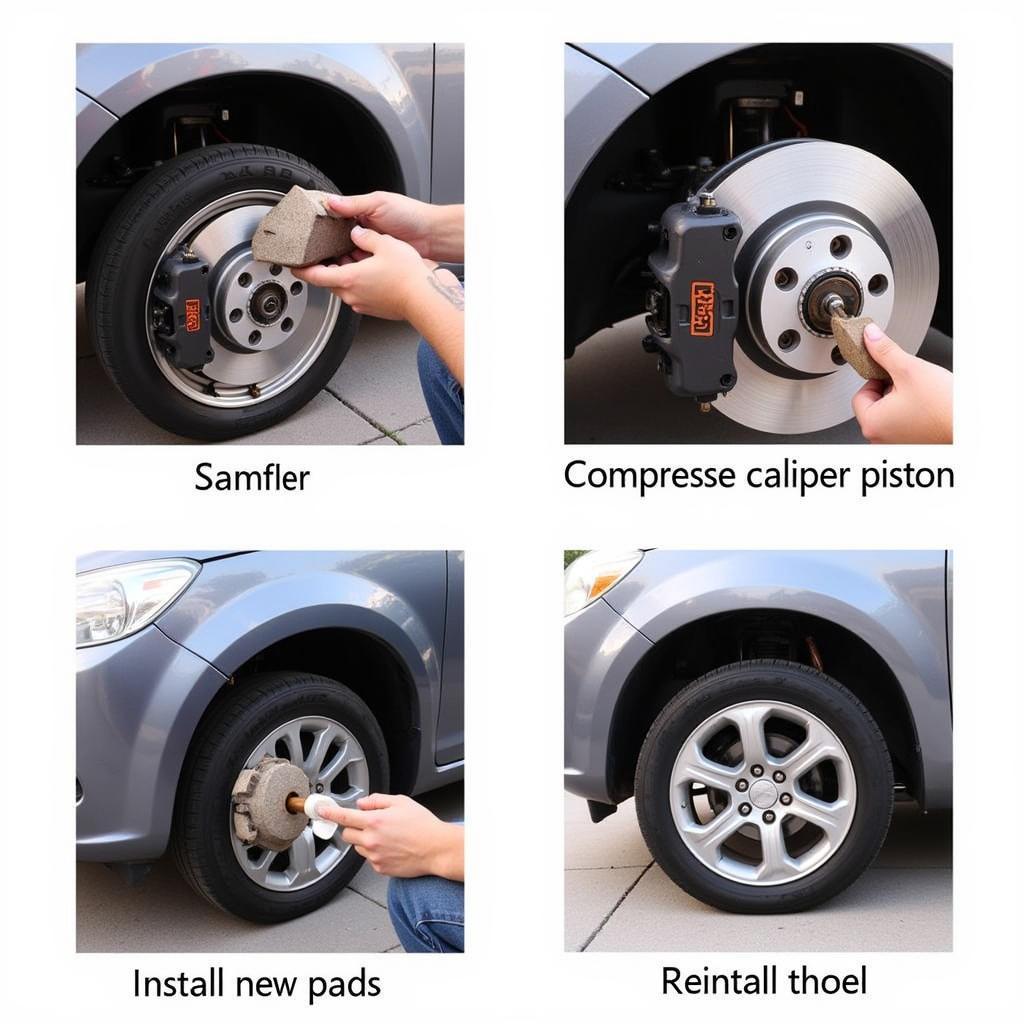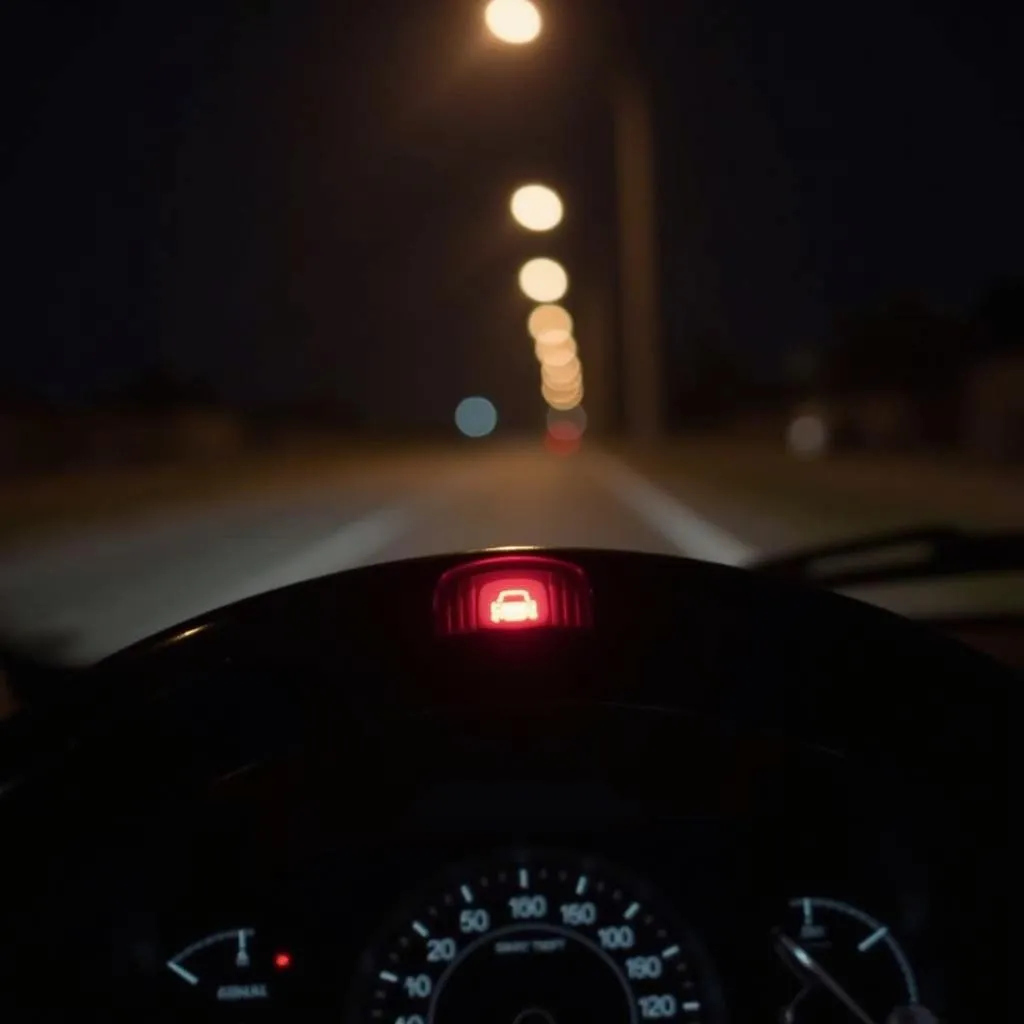If you’re driving a 2014 vehicle and see a low brake pad warning light, it’s crucial to address the issue promptly. This light is your car’s way of telling you that your brake pads are wearing thin and need attention. Ignoring this warning can compromise your safety and lead to more costly repairs down the road. This article delves into the common causes of a 2014 low brake pad warning light and provides a step-by-step guide on how to diagnose and potentially fix the problem.
Understanding Your Brake Pad Warning System
Most vehicles, including 2014 models, use a sensor-based system to monitor brake pad wear. Here’s how it works:
- Wear Indicators: Small metal tabs, called wear indicators, are attached to the brake pads. As the pad material wears down, these tabs eventually contact the brake rotor.
- Electrical Circuit: When the wear indicator rubs against the rotor, it completes an electrical circuit.
- Dashboard Warning: This triggers the low brake pad warning light on your dashboard, often a symbol of a circle with parentheses around it and an exclamation mark (!) in the center.
Why is My 2014 Low Brake Pad Warning Light On?
While worn brake pads are the most common reason, other possibilities exist:
- Worn Brake Pads: This is the most likely culprit. As brake pads wear down with use, the wear indicator will eventually make contact with the rotor, triggering the warning light.
- Damaged Brake Pad Sensor: The sensor itself might be faulty or damaged, causing the light to illuminate even if the brake pads are still in good condition.
- Worn Brake Rotor: In some cases, a severely worn or damaged brake rotor can interfere with the brake pad sensor, triggering the warning light.
- Brake Fluid Leak: A leak in your brake system can lead to a drop in brake fluid pressure. Since the brake pad warning system often shares a circuit with the brake fluid level sensor, this can also trigger the light.
- Electrical Problem: A short circuit or wiring issue in the brake pad warning system can cause a false positive.
Diagnosing the Problem
Here’s how you can troubleshoot a 2014 low brake pad warning light:
- Check Your Brake Fluid Level: Locate the brake fluid reservoir under your hood and ensure the fluid level is within the minimum and maximum markers.
- Inspect Your Brake Pads: If possible, take a look at your brake pads through the wheel spokes. Look for significant wear – if the pad material is less than ¼ inch thick, it’s time for a replacement.
- Listen for Noises: Unusual noises, such as grinding or squealing when you apply the brakes, can also indicate worn brake pads.
What to Do Next
If you suspect any of the following:
- Brake Fluid Leak
- Damaged Brake System Components
- Electrical Problems
Consult a qualified mechanic immediately. These issues require professional diagnosis and repair.
If you are comfortable with basic car maintenance and are confident that worn brake pads are the issue, you can replace them yourself.
* **{width=1024 height=1024}**Can I Drive with the Low Brake Pad Warning Light On?
It’s highly discouraged to continue driving with the low brake pad warning light illuminated, especially for extended periods. Driving with worn brake pads significantly reduces your braking effectiveness and increases the risk of an accident.
Tips for Extending Brake Pad Life
- Anticipate Stops: Coasting to a stop instead of slamming on the brakes reduces wear and tear on your brake pads.
- Lighten the Load: Carrying excess weight in your vehicle puts additional stress on your brakes.
- Avoid Riding the Brakes: Resting your foot on the brake pedal, even lightly, can cause unnecessary friction and wear on the pads.
- Regular Maintenance: Follow your vehicle manufacturer’s recommended maintenance schedule for brake inspections and fluid flushes.
FAQs about Low Brake Pad Warning Lights
1. How much does it cost to replace brake pads?
The cost of brake pad replacement varies depending on your vehicle’s make and model, the type of brake pads you choose, and labor costs in your area. On average, expect to pay between $150 and $300 per axle.
2. How often should I replace my brake pads?
Brake pad lifespan varies greatly depending on driving habits and conditions. As a general rule of thumb, it’s a good idea to have them inspected every 12,000 miles and replace them when the pad material is less than ¼ inch thick.
3. Can I replace just one brake pad?
While it’s technically possible to replace only one brake pad, it’s generally recommended to replace both pads on the same axle simultaneously. This ensures even braking force and wear.
4. What happens if I ignore the brake pad warning light?
Ignoring the warning light can lead to severe consequences, including:
- Metal-on-Metal Contact: Worn-out pads can allow the metal backing plate to contact the rotor, leading to costly rotor damage.
- Reduced Braking Performance: Driving with extremely worn brake pads can significantly increase your stopping distance, making it dangerous to drive.
- Brake Failure: In extreme cases, driving with severely worn brake pads can result in complete brake failure.
5. Can I use any brake pads for my 2014 vehicle?
It’s essential to consult your owner’s manual or a trusted mechanic to determine the correct type of brake pads for your specific 2014 vehicle model. Using the wrong type of brake pads can compromise braking performance and safety.
Don’t Ignore the Warning
A 2014 low brake pad warning light is a serious safety concern that should never be ignored. By understanding the causes, following the diagnostic steps, and taking prompt action, you can ensure your vehicle’s braking system remains in top condition, keeping you and others safe on the road. If you are unsure about any aspect of your brake system, always consult a qualified mechanic for professional assistance.


